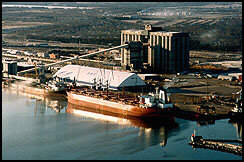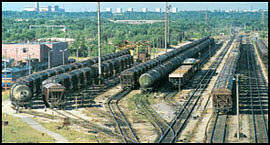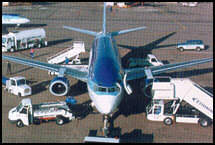 Estonia´s privatization Estonia´s privatization |
Relations with Russia are steadily improving as well. This year the bilateral negotiations on trade issues are supposed to come to an end and this will mean free trade between Estonia and Russia. Russia wants to become a member of the World Trade Organization and it has to abolish higher tariffs on Estonian imports. Besides Finland, Sweden and other Western European countries Russia still remains one of the main trading partners of Estonia.
Estonia became a member of the World Trade Organization last fall.

The Estonian overall trade volume is the same of an American average city, but it is growing about 10% a year. Out of one of the 15 Soviet republics that were on the verge of economic collapse 10 years ago Estonia is on the point of merging with the global economy.
One of the key factors of success, the privatization process started in 1992. At this time 90% of the companies were then owned by the state. Now only a few companies are left to privatize.
During the first years of rapid privatization Estonia sold most of the companies through the Privatization Agency and in 1995 the process was almost finished. The method of selling state companies was taken over from Germany, where it was called Treuhand. The idea was to sell the entities to the strategic investors, having no particular preferences for local investor and having a common basis for all applicants.
Following this method Estonia privatized for cash, not for vouchers. Voucher privatization would have given a false sense of ownership to the people who got vouchers and the collapse of the privatization process in Russia is an example of this.
In its early stage, the privatization process had some setbacks. "The Estonian companies, who were involved in privatization could not make privatized companies work efficiently enough and that caused a so-called second round of privatization," recalls Minister of Economic Affairs and the chairman of the Council of the Privatization Agency Mihkel Pärnoja. The local companies had almost no experience and views on modern market economies were not developed. That created some negative responses amongst the general public towards the privatization process.
Pärnoja tells that at the moment the attitude towards foreign investors is much more positive. Now they are seen as important partners.
Besides privatization the main part of the state owned enterprises were liquidated or became bankrupt. The successfully privatized ones are now operating well. Because of the very successful privatization in 1992-1995 Estonia was in a better situation compared to Latvia, Lithuania and Ukraine.
In 1995 after the elections the process slowed down a bit. The main reason was that the government did not have a clear political position and program for selling the remaining large companies.
Selling The Estonian Shipping Company three years
ago was the first large privatization deal, where
the government had to choose between two main bidders,
both international consortiums. Now the company
belongs to US Stanton Capital Group. |
Last year one of Estonia's largest companies, Estonian Telecom, was privatized through an IPO: 24% of the company was sold to small investors. The rest of the company belongs to two large strategic investors: Nordic telecom giants Telia and Sonera. The outcome of the IPO was better than expected and now Estonian Telecom is listed on the London Stock Exchange.

The other big privatization tender is the largest company in the country, Estonian Energy, which has annual turnover more than 4 billion kroons (250 millions USD). The biggest and most important part of the energy company, namely the electric stations has been offered and negotiations are going on with US company NRG Energy.
This year a transport giant, Estonian Railways will be privatized. It will be open tender for strategic investors and the government has decided to finish with it this year. The railway is the main channel for transit trade from East to West, transit from Russia makes 10-15% of GDP.
The Estonian Railways infrastructure is 1100 km train track. The whole network is 1900 km. The company owns 4500 railcars and 100 locomotives. There are 30 trains to and from Russia every day; one train is roughly 5000 tons.
Up to now British Railways has shown interest in investing into Estonian Railways. "Our philosophy is to look for strategic investors, private companies. Maybe not so much private companies in Europe, some might be in the UK, in the US," says Parbo Juchnewitsch, the general director of Estonian Railways.

According to the Minister of Transport and Communications Toivo Jürgenson, the Estonian government has also Tartu Airport and the TV and Radio Transmission Company on this year's privatization list.
This year government will find strategic investors for Paldiski Port close to Tallinn and a former Soviet military Ämari Airport next to Paldiski. Some well-known companies from Europe and North America have already shown their interest in Ämari Airport, Jürgenson says.
During the years of privatization, Estonia experienced the fastest economic growth period of GDP. In 1997 the GDP rose 10% on an annual basis. Now the opportunities left for foreign investors are green-field investments. The biggest investment opportunities lie in pulp mill factories and oil production from oil shale.
The Estonian government had promised to privatize the rest of Estonian Telecom this year, but the process will be delayed for the next 2 years, because the telecom market has become too volatile in connection with the decline of IT-and telecom-related shares on international markets. The Government plans to invest the money from selling the Telecom in a new social security and pension system. |

